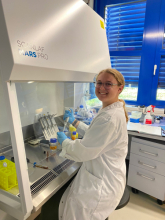
University:
Major:
Site Abroad:
Mentor(s):
Faculty Sponsor(s):
Faculty Sponsor's Department:
Project Title:
Project Description:
Engineered living materials (ELMs) is an emerging field involving encapsulation of living organisms within various polymer matrices. Among diverse applications of ELMs, utilizing genetically engineered bacteria within material systems as drug delivery systems is being explored with high interest. Recent studies involving E. coli-based ELMs have shown that the polymer matrix can impact the growth and expression rates of the encapsulated bacteria. In our project, we encapsulate different genetically modified bacteria into a hydrogel system based on modified polyvinyl alcohol (PVA-VS), a polymer widely used for biomedical applications. Material properties are characterized, and the behavior of different encapsulated bacteria in the hydrogels (genetically engineered E. coli, Clearcoli, Lactobacillus plantarum, and Corynebacterium glutamicum) is studied.
Characterization of the PVA-VS hydrogels was performed in several ways. Solubility studies of the polymer in the culture mediums used to grow the bacteria were carried out and analysis of the transparency was performed by measuring the transmittance of the gels in the visible region (400-800nm). With the help of rheological techniques, crosslinking kinetics were analyzed as well as swelling behavior, a key property of ELMs.
Different strains of the engineered bacteria studied were observed regarding growth, and functionality within the material over time using an ATP assay based on bioluminescence. Other influences on the growth of the bacteria were also studied, such as different ratios of PVA to the chemically crosslinkable PVA-VS and different medium concentrations. The bacteria required more nutrients than 1x concentrated medium provided so the response to 2x medium was studied and showed that the bacteria were able to survive better. The optimization of polymer composition, degree of crosslinking, and medium usage was done to achieve a continuous viable state of the bacteria within the hydrogels.
The project will continue with further focus on encapsulation of drug-producing bacteria within PVA-VS material, analyzing the drug release, and adapting the material properties based on the intended therapeutic effect.
